In the span of the past decade, full-time work outside the home has lost some of its appeal to mothers. This trend holds both for mothers who have such jobs and those who don’t.
Among working mothers with minor children (ages 17 and under), just one-in-five (21%) say full-time work is the ideal situation for them, down from the 32% who said this back in 1997, according to a new Pew Research Center survey. Fully six-in-ten (up from 48% in 1997) of today’s working mothers say part-time work would be their ideal, and another one-in-five (19%) say she would prefer not working at all outside the home.
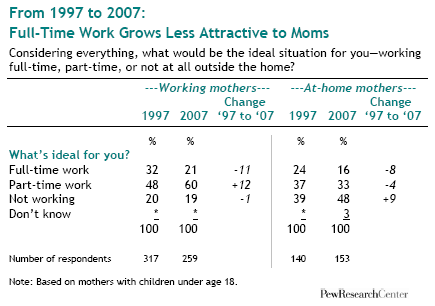
There’s been a similar shift in preferences among at-home mothers with minor children. Today just 16% of these mothers say their ideal situation would be to work full time outside the home, down from the 24% who felt that way in 1997. Nearly half (48%) of all at-home moms now say that not working at all outside the home is the ideal situation for them, up from the 39% who felt that way in 1997.
The lack of enthusiasm that mothers of all stripes have for full-time work outside the home isn’t shared by fathers – more than seven-in-ten (72%) fathers say the ideal situation for them is a full-time job.
Meantime, even as mothers have grown less enamored with full-time work, a new division of opinion has opened up between working moms and at-home moms on the question of whether it’s good or bad for society that more mothers are working outside the home.
A decade ago, nearly identical pluralities of both groups (38% among at-home moms; 39% among working moms) said this trend was bad for society. Since then, more working mothers have come to see this trend as good for society, while slightly more at-home moms have come to see it as bad.
There are also differences in the way working moms and at-home moms assess the job they’re doing as parents. Mothers working full-time give themselves slightly lower ratings as parents, on average, than do at-home mothers or mothers employed part-time.
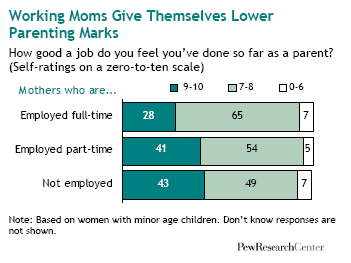
This self-rating question about parenting performance wasn’t asked on the 1997 Pew survey, so there is no way to know whether these patterns have changed over time.
The parenting ratings also vary by level of education; mothers with more education tend to be harder on themselves than are mothers with less education.
As for the shifts in attitudes among mothers about full-time work, these come at a time when the labor force participation rate of all women ages 25 to 54, after rising sharply over the past half century, has been basically unchanged since the mid 1990s, plateauing at about 75%. Among mothers with very young children (under 3 years of age), there was a small decline in the labor force participation rate between the peak year of 1998 (62%) and the most recent year for which figures are available, 2005 (59%).1
The survey did not probe the reasons women say one work situation or another would be ideal, so it can offer no details about the way mothers see the roles of working and childrearing in their lives.
The Pew survey was conducted by telephone from February 16 through March 14, 2007 among a randomly selected, nationally-representative sample of 2,020 adults. The margin of error is plus or minus 3 percentage points. Many of the analyses presented in this report are based on responses among selected subgroups. Results based on working mothers (259 respondents to the survey) have a margin of sampling error of plus or minus 8 percentage points. Results based on at-home mothers (153 respondents) have a margin of sampling error of plus or minus 11 percentage points.
Whenever possible, these findings have been compared with a nationally-representative survey of 1,101 women conducted in 1997 by the Pew Research Center for the People & the Press. The subgroup of women in the 1997 survey who are working mothers (317 respondents) and at-home mothers (140 respondents) have a margin of sampling error of plus or minus six and nine percentage points, respectively.
The Elusive Lure of Part-time Work
The mothers in the Pew survey who were most inclined to endorse their current situation as representing their ideal are those who work part-time. Among this group, fully eight-in-ten says that part-time work is their preferred option.
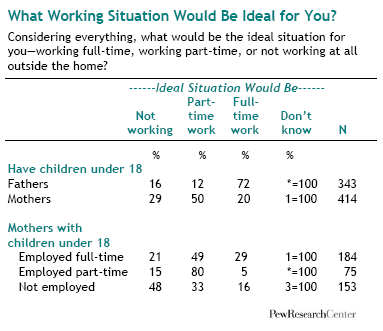
Part-time work is also the preferred option of about half (49%) of mothers who work full-time and a third (33%) of mothers who don’t work outside the home. It is much less popular among fathers; about seven-in-ten (72%) men with minor age children say that full-time work is their ideal situation, while 12% say they would prefer to work part-time and 16% say they would prefer not working outside the home.
Among women with minor children, views on this question vary little by income or education level. There are minor differences by race. Black mothers are more likely than whites to say full-time work is ideal; both groups are about equally likely to say no outside employment is ideal.2
Married mothers are somewhat more likely than unmarried mothers to consider no or part-time employment ideal; this pattern occurs in both the 1997 and 2007 Pew surveys. However, unmarried mothers are much less likely to prefer full-time work today (26%) than a decade ago (49%). A plurality of today’s unmarried mothers now prefer part-time work (46%), while 26% prefer not working outside the home and 26% prefer full-time work.
Mothers with younger children (ages 0 to 4 years) also are less likely to prefer full-time work today (16%) than a decade ago (31%). A narrow plurality (37%) preferred part-time work in 1997; today 48% of mothers with younger children prefer part-time work, while 36% prefer not working outside the home and 16% prefer full-time work. The preferences of mothers with older children (ages 5 to 17) are about the same today as they were a decade ago.
The decline in mothers saying full-time work is ideal for them occurred about equally among mothers with higher and lower education levels.
Among all working mothers, there’s a strong disconnect between the kind of job they say would be ideal and the kind of job they actually have. Some 60% of working mothers say they’d prefer to work part-time, but — according to figures from the U.S. Bureau of Labor Statistics – only about a quarter (24%) of all working mothers have a part-time job.3
How Mothers Assess Societal Impact of Working Moms
Working and at-home moms are divided in their judgments about the impact on society of working mothers.
A 44% plurality of at-home moms consider the increase in working mothers bad for society while about half as many (22%) say it is good for society and the remainder take a neutral position (31%). By contrast, working moms are split almost evenly between positive (34%), negative (34%), and neutral (31%) views of how this trend is affecting society.
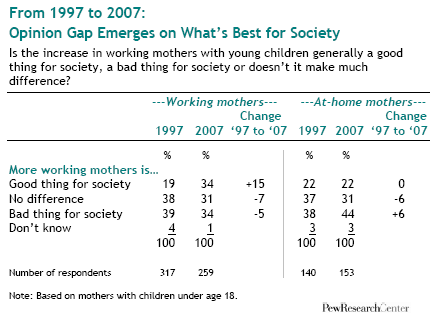
As noted above, the opinion divide on this question between at-home and working moms has emerged over the past decade. In the 1997 Pew survey, about equal proportions of at-home moms (38%) and working moms (39%) said the increased number of mothers in the labor force was a bad thing for society.
Married mothers are more likely than their unmarried counterparts to consider the growth of working mothers bad for society. Younger mothers (as well as younger women without children) are less negative about this societal trend.
Mothers with some college or more education have grown somewhat more positive than mothers with less education about the impact of working mothers on society. For example, 24% of mothers with a college degree say more working mothers is a good thing for society, up from 9% in 1997. Mothers with no more than a high school diploma are about equally likely to say this trend is a good thing for society now (32%) as did so a decade ago (27%).
What’s Best for the Kids?
Judgments about the impact of working mothers on society are strongly related to beliefs about what is best for children. Here too, at-home moms and working moms have different views, although neither group sees a full-time working mother as ideal for children.
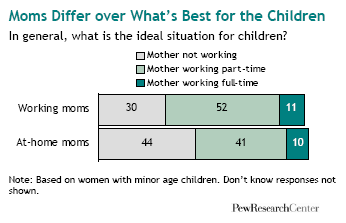
At-home mothers (44%) are more likely than employed mothers (30%) to say an at-home mom is the ideal situation for children. The at-home group is narrowly divided over whether part-time (41%) or no outside work (44%) is the ideal situation for children. Just one-in-ten says a full-time working mother is ideal for the children.
A majority of working mothers (52%) say that a mother working part-time is ideal for children. Three-in-ten say a mother who doesn’t work outside the home would be ideal for children and about one-in-ten (11%) say that a full-time working mother is ideal for children.
African-American mothers (83 respondents to this survey) are more likely than white or Hispanic mothers to consider employed moms – especially full-time working moms – ideal for children. Unmarried mothers are a bit more likely than married mothers to consider a mom working full-time ideal for children. Both black and unmarried mothers participate in the labor force at higher rates than their respective female counterparts. Mothers’ views on this question do not vary by education level.
How’s Your Parenting Going?
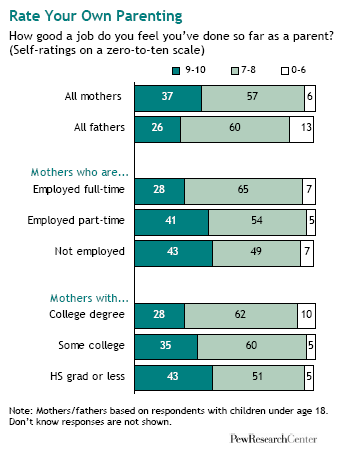
The Pew survey asked parents to rate how good a job they are doing as parents, on a scale from 0 to a high of 10. Regardless of their employment status, most mothers tend to give themselves relatively high marks on this scale. However, the women who are hardest on themselves are full-time working moms. Just 10% of mothers working full-time give themselves the highest rating (10) as a parent; another 18% place themselves at the next highest mark (9).
At-home moms give themselves more kudos as parents; nearly three-in-ten (28%) give themselves the highest mark (10) and another 15% put themselves at nine on this ten-point scale. Moms working part-time (just 75 respondents to this survey) give themselves similar marks; 24% of this group rates their job as a ten and another 17% rates themselves just one rung down at a nine.
Mothers see themselves in a better light, on average, than do fathers. Just 26% of dads give themselves one of the two highest marks; six-in-ten put themselves at a seven or eight on this scale and the remaining 13% rate themselves at six or below. (Most fathers of minor children in the Pew survey are full-time workers (85%); thus ratings among full-time working dads are virtually the same as those for all dads.)
Mothers with more education tend to be harder on themselves than are those with less education. By contrast, there is no clear relationship between father’s parenting rating and education level.
Public Opinion about Working Mothers
On questions related to work and motherhood, the views of the full adult population are not much different from the views of mothers themselves. The public is broadly ambivalent – but tilts more negative than positive –about the phenomenon of mothers working outside the home.
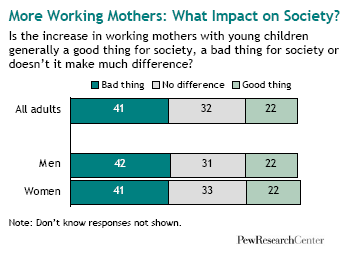
The Impact on Society of Working Mothers. A plurality of the general population (41%) says the trend toward more mothers working outside the home is a bad thing for society, while 22% say it is a good thing and 32% say this trend hasn’t made much difference.
The Pew survey also asked respondents to assess the impact on society of eight other trends related to family life – including the increase in single women having children; the increase in people living together without marrying; and the increase in people marrying at older ages. Of these nine, “more mothers of young children working outside the home” was in about the middle of the pack, reflecting the mixed views Americans hold about the impact of working mothers on society.
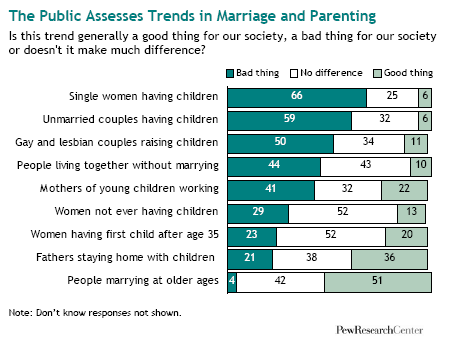
There is virtually no difference of opinion between men and women in assessments about the social impact of more mothers of young children working outside the home. Younger adults (especially those under age 30) are more positive, on average, than older adults about the impact of this trend. These age differences are more pronounced among women than among men, however.
Respondents who grew up with a working mom are less negative about the impact of working mothers on society than are respondents whose own mother was not employed at the time they were growing up.
African-Americans and Hispanics are a bit more positive than whites about the impact of working mothers on society. Republicans, political conservatives and white evangelical Protestants are more negative than their respective counterparts about the impact of working mothers on society. There are no or minimal differences in opinion on this question by education or income.
Working Mothers and Children. About four-in-ten (42%) adults say an at-home mother is the ideal situation for children; a nearly identical proportion (41%) say a mother working part-time is ideal and just 9% say a mother working full-time is ideal for children.
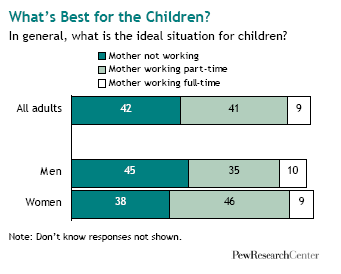
Men are more likely than women to consider an at-home mother the ideal situation for children. The same gender difference is found between moms and dads with children under age 18; fathers of minor age children are more likely than mothers to consider an at-home mom the ideal situation for children.
There are no or minimal differences in judgments about the ideal situation for children by education or family income. Blacks are more likely than either whites or Hispanics to hold full-time working moms as the ideal for children, but a plurality of blacks holds the part-time working mother as ideal, not the full-time worker. Republicans, political conservatives and white evangelical Protestants are more likely than their respective counterparts to consider an at-home mom ideal for the children.
About the Survey
Results for this survey are based on telephone interviews conducted with a nationally representative sample of adults, ages 18 years and older, living in continental U.S. telephone households. The sample design included an oversample of African-American and Hispanic respondents, as well as an oversample of 18 to 49 year olds. The oversample of African- American and Hispanic respondents was created by contacting a disproportionate number of area code-exchange combinations with higher than average densities of African-American and Hispanic households. The oversample of 18 to 49 year olds was achieved by screening additional replicates for age appropriate respondents. The data are weighted to produce a final sample that is representative of the general population of adults in the continental United States.
- Interviews conducted Feb. 16 – Mar. 14, 2007
- 2,020 interviews
- Margin of sampling error is plus or minus 3 percentage points for results based on the total sample at the 95% confidence level. The margin of sampling error is higher for results based on subgroups of respondents.
- The margin of sampling error is higher for results based on subgroups of respondents. The margin of error for the following subgroups is:
- Working mothers +/- 8 percentage points
- At-home mothers +/- 11 percentage points
- Survey interviews conducted under the direction of Princeton Survey Research Associates International. Interviews were conducted in English and Spanish.
Bear in mind that question wording and practical difficulties in conducting surveys can introduce error or bias in the findings of opinion polls.
Read the full report for more details.




